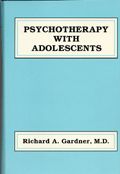|

|
PSYCHOTHERAPY WITH ADOLESCENTS Includes specific techniques and verbatim clinical vignettes |
|
HIGHLIGHTS
|
|
The book begins with a description of developmental conflicts of adolescence important to understanding and treating adolescent psychopathology. Of particular interest is Dr. Gardner's theory of the five stages in the development of the internal guilt-evoking mechanisms. This theory is of particular value in understanding and treating antisocial youngsters. He also discusses in detail the adolescent's delusions of invulnerability. Next Gardner discusses common environmental situations (especially family) that are conducive to the development of psychopathological reactions in adolescents. Particular focus is given to factors that result in deprivation of parental affection'a common central element in bringing about psychopathology. The next two chapters are devoted to diagnostic evaluations (both initial and intensive) in which he focuses on interview techniques that enable the examiner to learn about the psychodynamic factors that underlie and contribute to the development of a youngster's symptoms. Next, he describes in detail the central elements in the development of psychogenic psychopathology as well as the crucial factors that are operative in the psychotherapeutic process. Numerous clinical vignettes complement the theoretical material. This lengthy section'the heart of the volume'includes detailed descriptions of individual, group, and family therapy with adolescents. Last, Gardner devotes a chapter to the treatment of antisocial behavior, probably the most common problem for which adolescents are referred for therapy. |
